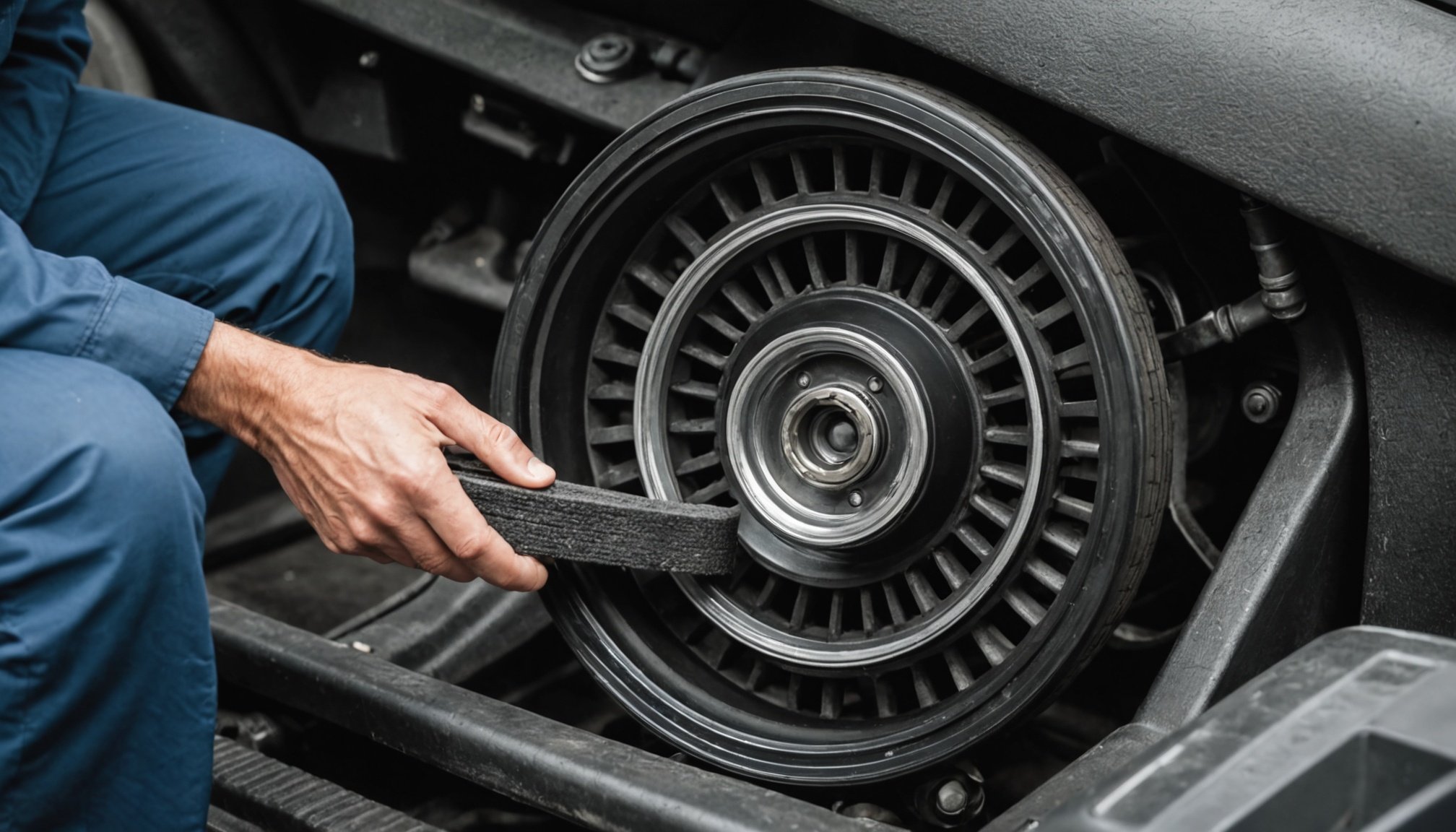Importance of the Drive Belt in Vehicle Functionality
The drive belt plays a crucial role in vehicle performance and safety. An integral component of the engine, it connects and powers essential devices such as the alternator, power steering pump, and air conditioning compressor. Each of these components relies on the drive belt to function properly, making it a key contributor to both engine efficiency and driver comfort.
The integrity of the drive belt directly impacts overall vehicle performance. A well-maintained drive belt ensures that various systems work harmoniously, avoiding undue stress on the engine and reducing the risk of wear on other parts. Conversely, a worn or damaged belt can lead to performance issues, including decreased horsepower and compromised fuel efficiency.
Also to see : Optimal Tire Pressure for Sports Cars Tackling Wet UK Roads: Expert Guidance
Critically, drive belts are foundational to automotive safety. A failing belt can result in the sudden loss of power steering or electricity, which is crucial for safe driving. Ensuring that the drive belt system is in optimal condition can prevent unexpected breakdowns, thus enhancing automotive safety. Regular checks and maintenance prevent minor issues from escalating into major safety concerns.
Understanding the drive belt’s purpose not only aids in recognising its importance but also encourages proactive maintenance, offering a pathway to improved longevity and reliability of the vehicle.
In the same genre : Boosting safety: key strategies to optimize your vehicle”s automatic transmission performance
Safety Implications of Neglecting Drive Belt Maintenance
Neglecting drive belt maintenance can pose significant vehicle safety risks. A compromised drive belt might lead to sudden engine failure due to its critical role in maintaining engine functionality. It powers essential components like the alternator and power steering pump, and failure can result in immediate loss of power, severely affecting vehicle control.
In scenarios where drive belt failure occurs unexpectedly, the risk of accidents increases. For instance, a sudden loss of power steering can make it difficult to manoeuvre the vehicle, especially at high speeds or in critical driving conditions. This could lead to potentially dangerous incidents on the road. Real-life examples of crashes and roadside breakouts often cite drive belt malfunctions as a contributing factor, highlighting the importance of routine checks.
Moreover, unexpected drive belt issues can lead to electricity loss, which is vital for operating lights and indicators. This underscores the importance of preventative maintenance. Regular inspections can identify early signs of wear, reducing the risk of safety incidents caused by neglected maintenance. Taking these preventative steps not only protects you but also contributes to broader road safety by minimizing the likelihood of accidents due to mechanical failure.
Recommended Maintenance Practices for Drive Belts
Routine drive belt inspection is essential in maintaining optimal vehicle performance and ensuring automotive safety. Regular checks help detect signs of wear and prevent failure, thereby maintaining the functionality of critical engine components.
Drive belt maintenance involves monitoring the belt for cracks, frays, and glazing, which indicate deterioration. Monthly visual inspections are advisable for early detection. While some drivers may perform basic checks, professional maintenance offers a comprehensive assessment. Trained automotive professionals can assess tension, alignment, and overall condition more accurately, reducing the risk of vehicle safety issues.
DIY maintenance can be effective with the right tools, such as a serpentine belt tool for tension adjustments and a flashlight for better visibility. However, understanding when to seek professional help is crucial.
Professional maintenance checks, done annually or bi-annually, ensure that problems like misalignment are addressed correctly. Expert advice from qualified mechanics helps tailor service based on individual vehicle needs. Emphasizing warranties and guarantees reassures drivers about service quality, promoting confidence in professional care. By integrating these methodologies, drivers can ensure long-lasting drive belt systems, ultimately supporting better performance and safety standards.
Identifying Warning Signs of Drive Belt Wear and Tear
Keeping your vehicle diagnostics up-to-date includes being attentive to warning signs of drive belt wear and tear. Recognising these signs is essential for timely preventative maintenance.
Visual and Auditory Indicators
Visual inspection can reveal signs of fraying, cracks, or glazing on the belt. A shiny or slick appearance may signal excessive wear. These are clear indicators that it’s time for a replacement. Additionally, auditory cues such as squealing or chirping noises coming from the engine area often suggest that the belt may be loose or misaligned.
Performance Changes and Alerts
Performance changes are another aspect to monitor. Issues such as flickering lights, weak power steering, or a sudden lack of cooling from the air conditioning can be symptoms pointing towards a deteriorating drive belt. These can be critical for early diagnostics and avoiding further damage.
Consultation with Professionals
When these symptoms arise, consulting with an automotive professional is advisable. Professionals can pinpoint the cause and execute the necessary repairs. Relying on their expertise ensures the drive belt system’s integrity is maintained, and prevents potential vehicle performance issues. Regular checks and prompt responses to warning signs contribute significantly to maintaining automotive safety.
Cost Considerations for Drive Belt Maintenance and Replacement
Understanding the costs related to drive belt maintenance can assist in effective budgeting and prevent unplanned expenses. On average, a straightforward drive belt inspection or routine maintenance might set you back between £20 and £50. This is a modest price compared to the potential cost of neglected maintenance.
Factors influencing drive belt replacement costs include vehicle make, model, and the type of belt system. For instance, serpentine belts, common in most modern cars, usually range from £30 to £75. Labour charges, which differ by mechanic and region, can further affect the total. Additionally, complex setups may require more intensive labour, increasing overall service pricing.
Proactively addressing drive belt issues can save considerable money. Regular checks minimise the risk of sudden failures, sparing drivers from expenses related to more severe vehicle damage or emergency services. For instance, fixing a failing belt punctually avoids larger repair costs, such as those for alternator or power steering pump replacement.
Regular maintenance not only aids in regulating costs but also ensures consistent vehicle performance, enhancing long-term automotive safety. Allocating resources towards preventative car care is a wise financial strategy, supporting both the health of the vehicle and its operational efficiency.
Professional Service Recommendations for Drive Belt Care
When considering drive belt maintenance, enlisting the help of automotive professionals is invaluable. Qualified mechanics bring expertise and precision, ensuring optimal vehicle performance by addressing complex components accurately.
Identifying qualified mechanics is crucial. Look for technicians with certifications, such as ASE (Automotive Service Excellence), which reflect their expert knowledge. Reviews and recommendations can also guide you in selecting a reputable service provider. The importance of warranties and guarantees cannot be overstated; they provide confidence in the quality of the work performed and safeguard against potential issues post-service.
Choosing the right service depends on your vehicle type and specific needs. Different vehicles have distinct requirements, making expert advice essential. Professionals can customise maintenance schedules, ensuring the drive belt system remains durable and efficient. Regular consultation with experts not only enhances automotive safety but also extends the longevity of your vehicle.
Ultimately, investing in professional service is a proactive step toward reliable drive belt care. It combines the assurance of quality with tailored maintenance strategies, supporting both the immediate and long-term needs of your automobile. This approach naturally aligns with maintaining the highest standards of vehicle safety and efficiency.











